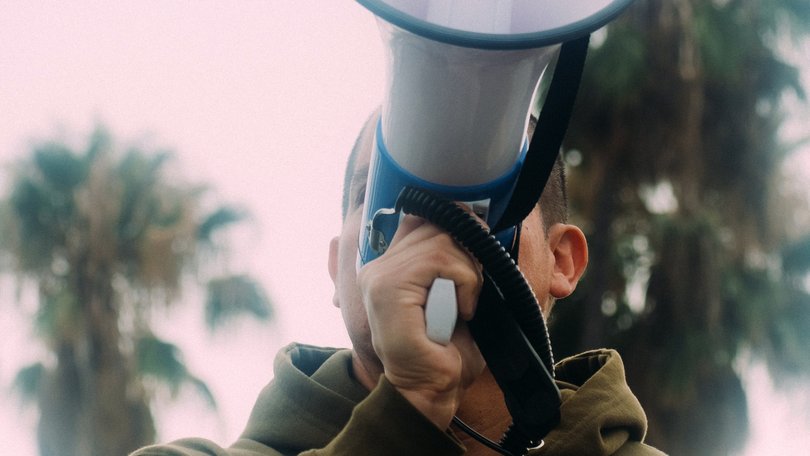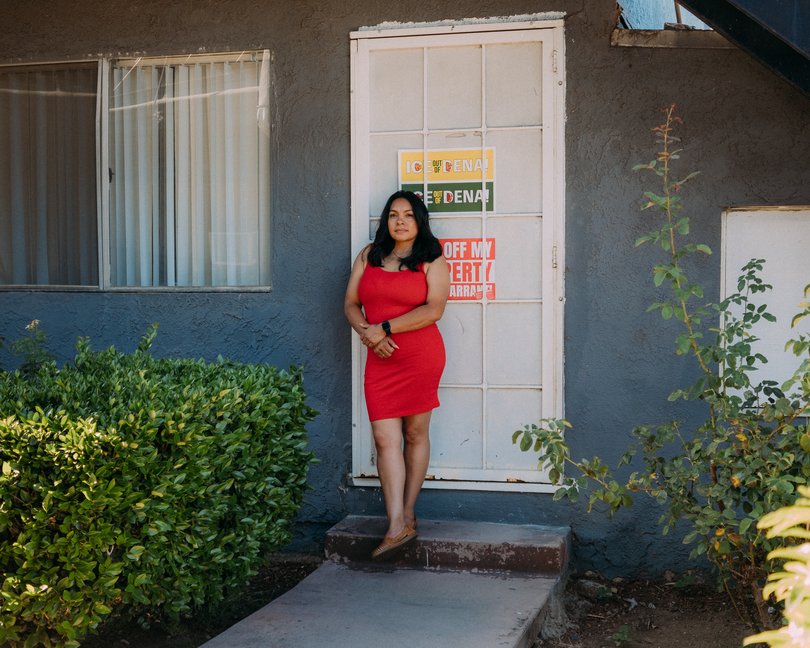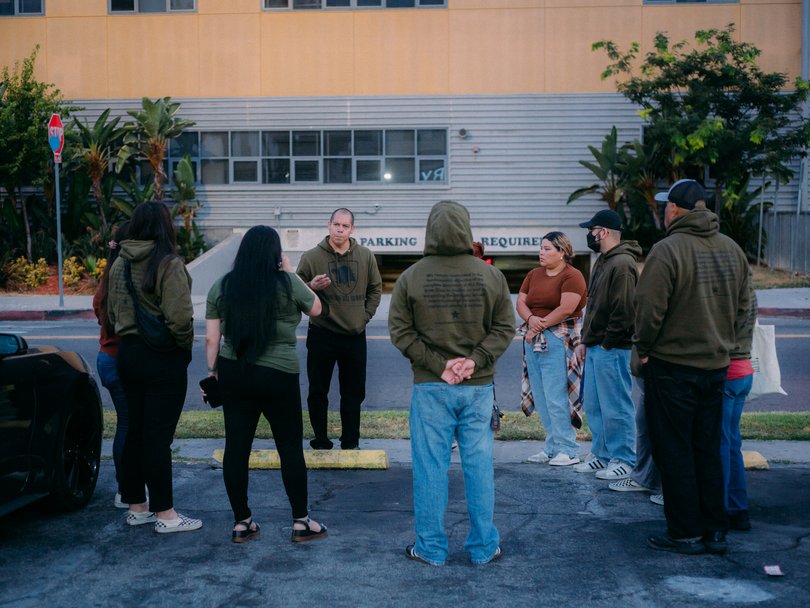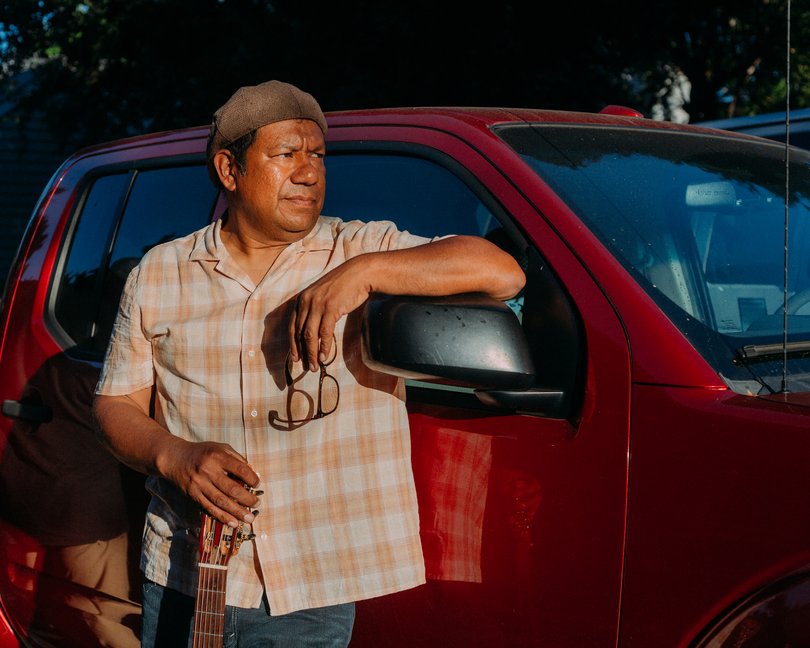THE NEW YORK TIMES: They saw their neighbours taken away by ICE, then they made a plan

Elizabeth Castillo wasn’t an activist until Immigration and Customs Enforcement started taking away her neighbours.
It all began in June, after Donald Trump directed Immigration and Customs Enforcement agents to sweep Los Angeles, then used scattered violence at protests of ICE’s tactics as a pretext to send in the military.
Castillo felt her working-class neighbourhood in Pasadena, just outside Los Angeles, was under siege. Six people, she said, were seized at a Winchell’s doughnut shop. Two people were taken when ICE raided her apartment complex.
Sign up to The Nightly's newsletters.
Get the first look at the digital newspaper, curated daily stories and breaking headlines delivered to your inbox.
By continuing you agree to our Terms and Privacy Policy.“It was just chaos,” she said. “And you can see, you can hear, you could feel the fear, the intimidation. You could feel the terror.”
A small woman with long dark hair, Castillo, the American-born daughter of Mexican immigrants, looks younger than her 38 years. She has five children, two of them grown, but three still at home.
Before the ICE crackdown she’d followed the news and always voted, but her kids and her job in health care administration took up most of her time. “You know, it’s practices here, practices there,” she said. “‘Mum, pick me up.’ ‘Mum, drop me off.’”
But she’s someone who knows firsthand what deportation can do to families. In 2012, she said, when her kids were all under 10, her husband, who was born in Mexico but grew up in the United States, was thrown out of the country.
She’d been a full-time student; he was the family’s sole provider. Castillo had to drop out of college and explain to her children why their father could no longer live with them. “I can relate to what it does to a family,” she said.
So this summer, when ICE started grabbing people from her community off the streets, she felt she had to act.

At first, Castillo was on her own with a megaphone. When she saw ICE vehicles in the streets she followed them in her car, honking and shouting to warn people that they were coming.
She started getting up before dawn to patrol her apartment complex. Then she contacted the National Day Labourer Organising Network, which runs a nearby job centre.
Through it, she was plugged into a citywide network of people who are constantly tracking ICE’s activities.
Among those doing amateur anti-ICE reconnaissance in Los Angeles are people from established nonprofits that work closely with the mayor’s office. Then there are more militant groups that, beyond simply documenting ICE’s operations, try to actively disrupt them.
“We have people patrolling all over the city starting at 5.30 in the morning,” said Ron Gochez, a high school teacher and spokesperson for one of the more radical organisations, Unión del Barrio. When they find agents, he told me, “We get on the megaphone. We denounce the terrorists for being there, and then we inform the community in the immediate area that they are present. And then we say to the people, ‘If you are documented, come out. Come outside. Join us. Help us to defend your neighbour.’”

The widespread raids that have upended life in Los Angeles may soon spread to other cities, especially now that Republicans in Congress have increased ICE’s budget to $27.7 billion, up from about $8 billion. (That’s more than that of most militaries.)
“We are a petri dish,” Mayor Karen Bass of Los Angeles said. “They’re experimenting with us. If they come and make this stand in Los Angeles, then they can scare all the other cities, just like the universities have been scared, just like the legal firms have been scared.”
Yet if Los Angeles is a testing ground for mass deportation, it’s also a place to see how the resistance is evolving. Though there have been some big anti-Trump marches this year, many of those most horrified by this administration are looking for more immediate, tangible ways to thwart it.
The movement against ICE in Los Angeles — one that is starting to take root, in different forms, in cities like New York — is part of a growing shift from symbolic protest to direct action.
It may be no match for the Trumpian leviathan. But it can protect a few people who might otherwise get swept into the black hole of the administration’s deportation machine. And in the most optimistic scenario, it could be a foundation for a new, nationwide opposition movement.
“We have been abandoned by the courts, by the business community” and, with few exceptions, “by the political class in Washington, D.C.,” said Pablo Alvarado, co-founder of the National Day Labourer Organising Network.
“All we have are our friends, our allies and ourselves.” One of his group’s slogans is, “Solo el pueblo salva al pueblo.” It means, “Only the people can save the people.”

These days, when Castillo isn’t working, she’s usually in the parking lot of a small, run-down shopping plaza on Orange Grove Boulevard and Garfield Avenue. There, with NDLON’s help, she and a few others who live nearby have set up a sort of command post that they call the community defence corner.
They have a canopy tent and literature tables. Each day, volunteers meet there from 6:30 a.m. until around 10 at night. Some of them are new to activism. Others have been protesting Trump since he was first inaugurated. They half-jokingly call Castillo their CEO. It stands, she says, for “controllo everything over here.”
The volunteers distribute know-your-rights flyers and pictures of ICE agents and vehicles that have been spotted in the area, along with the number of a hotline to report sightings. “Meet the Clown Squad fascists in your hood,” says one handout. There’s a pile of orange whistles to blow if you see something suspicious and beaded friendship bracelets with the phone numbers of local immigrant rights groups.
When the volunteers get word of a raid, they rush over to make a commotion. Wearing a custom black “Grupo Auto Defensa” T-shirt, Jesus Simental, a middle-aged man who works delivering industrial equipment, said: “They don’t want noise, and we bring the thunder.”
In the first Trump presidency, the resistance announced itself with the Women’s March, a gargantuan display of feminist fury at Trump’s improbable victory. No similar spectacle greeted his return. For those who abhor him, Trump’s reelection was devastating, but it wasn’t shocking. He’d won the popular vote, giving him a democratic legitimacy he didn’t have the first time around.
The dominant mood in many blue precincts was despair rather than outrage. Organised opposition to Trump seemed, at least to some observers, to be dormant. A Politico headline shortly after the election announced, “The Resistance Is Not Coming to Save You. It’s Tuning Out.”
While the exhaustion was real, it wasn’t the whole story. Anti-Trump forces may have been quieter than they were before, but they never stopped meeting and planning. As the administration exceeds many of its opponents’ worst fears, they’re becoming more visible.
Resistance in the second Trump term, however, looks a bit different than it did in the first. There’s less focus on big marches and rallies, and more on trying to make a concrete difference, often close to home.
Think of the doctors sending abortion medication into states with prohibitions or the protests in front of Tesla dealerships that helped push down the company’s stock price. “Resistance 2.0 is much more locally grounded and community embedded,” said Dana Fisher, an American University sociologist who studies protest movements.
This is, of course, a generalisation; there was plenty of civil disobedience and left-wing radicalism during Trump’s first term, especially in the febrile summer of 2020. But looking back from the bleak vantage of 2025, it’s striking how optimistic many people were that some established power in American life — be it Congress, law enforcement, government bureaucrats or the media — could stop Trump from doing his worst.
As such faith has withered, the character of the resistance has changed. “We recognise that in a period of authoritarian breakthrough where there is a very rapid sprint to consolidate power, you cannot focus purely on the formal political avenues of representation,” said Leah Greenberg, one of Indivisible’s founders. “Getting out of this is going to require a symphony of defiance.”
Indivisible is running a campaign called “One Million Rising” aimed at training a million people in strategies of protest, noncooperation and civil disobedience, especially around mass deportation.
The emphasis on ICE is in part simply a response to the sheer cruelty of Trump’s immigration regime. Far from prioritising criminals, ICE, under pressure from Trump’s fanatical deputy chief of staff Stephen Miller, seems desperate to round up as many people as possible.
That includes people with American spouses and children who’ve been here for decades, those who’ve followed all the rules in seeking asylum, and even those with green cards.
In recent months viral videos have shown ICE agents breaking car windows, throwing people to the ground and ripping parents away from their kids.
Human Rights Watch has reported on the degrading treatment of immigrants in federal detention; at one Florida facility, men described being forced to eat “like dogs” with their hands shackled behind their backs. Venezuelan migrants sent by the United States to a megaprison in El Salvador have reportedly faced even worse conditions; Andry Hernández Romero, a gay makeup artist later freed as part of a prisoner exchange, described being tortured and sexually assaulted by guards.
With ICE increasingly seen as the front line of a growing police state, people all over the country are looking for ways to stand up to it. In New York, ICE arrests seem to be concentrated in immigration courts, where agents have been snatching people after their asylum hearings, even when judges ask them to come back for further proceedings.
Activists, in turn, are showing up at the courts to try to provide whatever support to immigrants they can. They hand out flyers — languages include Spanish, French, Urdu, Punjabi and Mandarin — informing immigrants of the few rights they have. They collect emergency contacts and immigration ID numbers so that when people are arrested, someone can inform their loved ones and track them through the detention system.
When the hearings are over, the volunteers try, often in vain, to escort the immigrants past intimidating groups of masked, armed ICE agents to the elevators and onto the street. That’s what New York City’s comptroller, Brad Lander, was doing when he was arrested in June.
A week after that arrest, Lander was back in immigration court with his wife and daughter. After shouting ICE agents took the husband of a very pregnant woman from Ecuador, Lander’s wife, Meg Barnette, spent an hour consoling her, then connected her to an immigrant rights nonprofit. When a woman from Liberia collapsed, panicked and sobbing, after hours of watching other immigrants being dragged away, Lander’s daughter held her baby girl.
Because ICE’s efforts in New York have largely revolved around the courts, that hideous system has been hidden from much of the public. It’s more conspicuous in Los Angeles, where Trump has treated the entire city like a hostile colony to be subdued.
This month, armed ICE agents backed by National Guard troops, some on horseback or in armoured vehicles, stormed into the city’s MacArthur Park, forcing kids at a nearby summer camp to shelter inside.
Bass was livid, but the administration made clear that she had little authority. “I don’t work for Karen Bass,” the Border Patrol chief, Gregory Bovino, told Fox News. “Better get used to us now, because this is going to be normal very soon. We will go anywhere, anytime we want in Los Angeles.”
One thing Los Angeles has going for it, however, is a deep, established immigrant rights ecosystem. These groups, said Bass, “have prepared for this type of stuff in the past, though not as massive, not as egregious as this.”
Indeed, she told me her office relies on activist networks to keep abreast of ICE activity in the city. “That’s how I learn about where raids are happening,” she said. “It’s not like we’re notified of anything.”
It’s a jarring statement about the relative impotence of city government, but also a testament to what an important role the activists are playing.
Since Castillo and her neighbours started their community defence corner, a few others have popped up around Pasadena, including outside a Home Depot on East Walnut Street. The stores have become a central site in the battle over mass deportations; day labourers often gather there to look for work, making Home Depots a common target for ICE.
In response, groups of activists have, as they put it, “adopted” Home Depot locations, showing up in shifts to look out for immigration agents. On East Walnut Street, several of the day labourers told me they feel safer with the activists around. “There’s fear, but now we feel protected,” said one, knowing there will at least be a warning if ICE arrives.
While the community defence corner on East Walnut Street operates every day, extra people show up on Wednesdays, part of a weekly demonstration organised by a local librarian. Several of the protesters, mostly middle-aged and older women, told me they were part of local Indivisible chapters.
Alvarado, from the National Day Labourer Organising Network, was grateful for their presence. “The way we view it is that you stop fascism, you stop authoritarianism by protecting those that are at the end of the whip,” he said. “If you want to protect democracy, you protect the most vulnerable. That’s what we want people from all walks of life to understand. That’s why it’s beautiful to see the soccer mums, the teachers, getting it.”
There is, of course, only so much such resistance can accomplish in the face of a heavily armed, spectacularly well-funded and politically powerful deportation machine. More than 2,000 immigrants have been arrested in Los Angeles over the past month. Gochez, from Unión del Barrio, believes many more would have been taken without the work of groups like his, but there’s no way to quantify it.
Clearly, however, it matters that people are watching what ICE is doing. As Alvarado points out, a major reason public opinion is turning against Trump’s mass deportation campaign is the viral videos showing what it looks like in practice.
Activist groups train people to record ICE activities wherever they see them, helping to capture both arrests and agents’ aggression toward civilian observers. “Men in masks, wearing civilian clothes, pulling guns against people who are exercising their rights while filming, that’s exactly what Americans don’t like to see,” he said.
Alvarado is a citizen now, but he grew up in El Salvador, fleeing the civil war with his brother when he was 22. The sight of masked men taking people away to sites unknown feels to him familiar.
“This is a word I don’t take lightly, but people talk about disappearances,” he said of the situation in Los Angeles. “For now, it’s a stretch, I will say, but that’s how it starts. No right to due process. People just snatch you and put you in the vans. It’s something I’ve seen, and I know where that leads.”
To fight what’s coming, he believes, people will have to depend on each other. “Not by being violent and responding with more violence, but by building community and understanding,” he said.
This article originally appeared in The New York Times.
© 2025 The New York Times Company
Originally published on The New York Times
